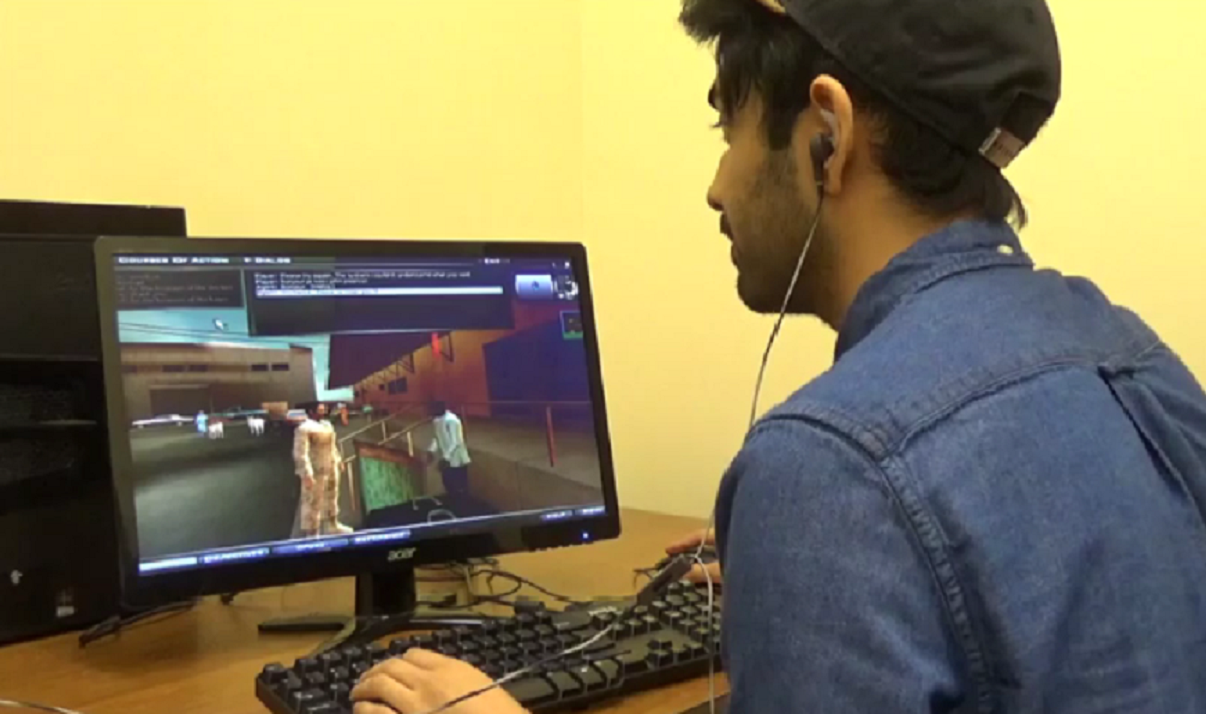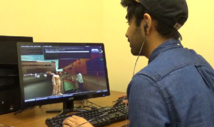New findings by scientists at the University of Washington (Seattle, U.S.) demonstrate that a five-minute measurement of resting-state brain activity predicts how quickly adults learn a second language.
The study, published in the journal Brain and Language, is the first to use patterns of resting-state brain rhythms to predict the subsequent language learning rate.
“We’ve found that a characteristic of a person’s brain at rest predicted 60 percent of the variability in their ability to learn a second language in adulthood,” said lead author Chantel Prat, a researcher of the Institute for Learning & Brain Sciences and an associate professor of psychology, as said in UW Today, echoes Tendencias21.
At the beginning of the experiment, volunteers –19 adults aged 18 to 31 with no previous experience in learning French– sat with their eyes closed during five minutes while wearing an EEG (electroencephalogram) headset. The headset measured the natural patterns of brain activity.
The course
Participants were to the lab twice a week for eight weeks for 30-minute French lessons through an immersive, virtual reality computer programme. The U.S. Office of Naval Research founded the study, including the language training programme.
The program, called OLCTS, aims to get military personnel functionally proficiency in a foreign language with only 20 hours of training. The personalised programme guides the users through a series of scenes and stories. A voice-recognition programme enables users to check their pronunciation.
To ensure that participants were paying attention, the researchers used periodic quizzes that required a minimum score before proceeding to the next lesson. The quizzes also served to measure for how quickly each participant moved through the curriculum.
At the end of the programme of eight weeks, participants completed the same proficiency test, no matter how many lessons they had finished. The fastest person learned twice as quickly but just as well as the slower learners. The recordings from the EEG headsets revealed that patterns of brain activity were the factor the most linked to the rate of learning of the participants.
So, should people that don’t have this biological predisposition giving up learning a new language? Prat says no, because the other 40% depends of factors such as motivation, and because it’s possible to change resting-state brain activity using neurofeedback training, a sort of brain training through which individuals can strengthen the brain activity patterns related to better cognitive abilities.
The study, published in the journal Brain and Language, is the first to use patterns of resting-state brain rhythms to predict the subsequent language learning rate.
“We’ve found that a characteristic of a person’s brain at rest predicted 60 percent of the variability in their ability to learn a second language in adulthood,” said lead author Chantel Prat, a researcher of the Institute for Learning & Brain Sciences and an associate professor of psychology, as said in UW Today, echoes Tendencias21.
At the beginning of the experiment, volunteers –19 adults aged 18 to 31 with no previous experience in learning French– sat with their eyes closed during five minutes while wearing an EEG (electroencephalogram) headset. The headset measured the natural patterns of brain activity.
The course
Participants were to the lab twice a week for eight weeks for 30-minute French lessons through an immersive, virtual reality computer programme. The U.S. Office of Naval Research founded the study, including the language training programme.
The program, called OLCTS, aims to get military personnel functionally proficiency in a foreign language with only 20 hours of training. The personalised programme guides the users through a series of scenes and stories. A voice-recognition programme enables users to check their pronunciation.
To ensure that participants were paying attention, the researchers used periodic quizzes that required a minimum score before proceeding to the next lesson. The quizzes also served to measure for how quickly each participant moved through the curriculum.
At the end of the programme of eight weeks, participants completed the same proficiency test, no matter how many lessons they had finished. The fastest person learned twice as quickly but just as well as the slower learners. The recordings from the EEG headsets revealed that patterns of brain activity were the factor the most linked to the rate of learning of the participants.
So, should people that don’t have this biological predisposition giving up learning a new language? Prat says no, because the other 40% depends of factors such as motivation, and because it’s possible to change resting-state brain activity using neurofeedback training, a sort of brain training through which individuals can strengthen the brain activity patterns related to better cognitive abilities.
New findings by scientists at the University of Washington (Seattle, U.S.) demonstrate that a five-minute measurement of resting-state brain activity predicts how quickly adults learn a second language.
The study, published in the journal Brain and Language, is the first to use patterns of resting-state brain rhythms to predict the subsequent language learning rate.
“We’ve found that a characteristic of a person’s brain at rest predicted 60 percent of the variability in their ability to learn a second language in adulthood,” said lead author Chantel Prat, a researcher of the Institute for Learning & Brain Sciences and an associate professor of psychology, as said in UW Today, echoes Tendencias21.
At the beginning of the experiment, volunteers –19 adults aged 18 to 31 with no previous experience in learning French– sat with their eyes closed during five minutes while wearing an EEG (electroencephalogram) headset. The headset measured the natural patterns of brain activity.
The course
Participants were to the lab twice a week for eight weeks for 30-minute French lessons through an immersive, virtual reality computer programme. The U.S. Office of Naval Research founded the study, including the language training programme.
The program, called OLCTS, aims to get military personnel functionally proficiency in a foreign language with only 20 hours of training. The personalised programme guides the users through a series of scenes and stories. A voice-recognition programme enables users to check their pronunciation.
To ensure that participants were paying attention, the researchers used periodic quizzes that required a minimum score before proceeding to the next lesson. The quizzes also served to measure for how quickly each participant moved through the curriculum.
At the end of the programme of eight weeks, participants completed the same proficiency test, no matter how many lessons they had finished. The fastest person learned twice as quickly but just as well as the slower learners. The recordings from the EEG headsets revealed that patterns of brain activity were the factor the most linked to the rate of learning of the participants.
So, should people that don’t have this biological predisposition giving up learning a new language? Prat says no, because the other 40% depends of factors such as motivation, and because it’s possible to change resting-state brain activity using neurofeedback training, a sort of brain training through which individuals can strengthen the brain activity patterns related to better cognitive abilities.
The study, published in the journal Brain and Language, is the first to use patterns of resting-state brain rhythms to predict the subsequent language learning rate.
“We’ve found that a characteristic of a person’s brain at rest predicted 60 percent of the variability in their ability to learn a second language in adulthood,” said lead author Chantel Prat, a researcher of the Institute for Learning & Brain Sciences and an associate professor of psychology, as said in UW Today, echoes Tendencias21.
At the beginning of the experiment, volunteers –19 adults aged 18 to 31 with no previous experience in learning French– sat with their eyes closed during five minutes while wearing an EEG (electroencephalogram) headset. The headset measured the natural patterns of brain activity.
The course
Participants were to the lab twice a week for eight weeks for 30-minute French lessons through an immersive, virtual reality computer programme. The U.S. Office of Naval Research founded the study, including the language training programme.
The program, called OLCTS, aims to get military personnel functionally proficiency in a foreign language with only 20 hours of training. The personalised programme guides the users through a series of scenes and stories. A voice-recognition programme enables users to check their pronunciation.
To ensure that participants were paying attention, the researchers used periodic quizzes that required a minimum score before proceeding to the next lesson. The quizzes also served to measure for how quickly each participant moved through the curriculum.
At the end of the programme of eight weeks, participants completed the same proficiency test, no matter how many lessons they had finished. The fastest person learned twice as quickly but just as well as the slower learners. The recordings from the EEG headsets revealed that patterns of brain activity were the factor the most linked to the rate of learning of the participants.
So, should people that don’t have this biological predisposition giving up learning a new language? Prat says no, because the other 40% depends of factors such as motivation, and because it’s possible to change resting-state brain activity using neurofeedback training, a sort of brain training through which individuals can strengthen the brain activity patterns related to better cognitive abilities.



 English
English



